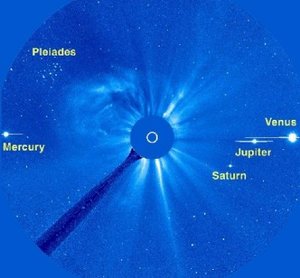12 May
1910: On 12 May 1910, Sir William Huggins died. William Huggins was an English amateur astronomer and the pioneer of spectroscopy. He built a private observatory in 1856 at Tulse Hill, South London and installed a highly-sensitive 8-inch refractor telescope.
He discovered dark-line spectra and in 1864 he examined the spectrum of a planetary nebula, NGC 6543 in Draco. He found that it had a bright line (emission line) spectrum including two green lines which could not be identified as of any known element at that time. These were then assigned to a new hypothetical element, 'Nebulium.'
He therefore concluded correctly that this nebula was not composed of stars, which have a continuous spectrum, but of glowing gas. In 1866, he made the first spectroscopic observation of a nova, Nova Coronae 1866, and found emission lines of hydrogen. In 1868 he studied the spectrum of a comet and identified the spectral lines of ethylene.
In 1899, he published an Atlas of Representatice Spectra.















 Germany
Germany
 Austria
Austria
 Belgium
Belgium
 Denmark
Denmark
 Spain
Spain
 Estonia
Estonia
 Finland
Finland
 France
France
 Greece
Greece
 Hungary
Hungary
 Ireland
Ireland
 Italy
Italy
 Luxembourg
Luxembourg
 Norway
Norway
 The Netherlands
The Netherlands
 Poland
Poland
 Portugal
Portugal
 Czechia
Czechia
 Romania
Romania
 United Kingdom
United Kingdom
 Slovenia
Slovenia
 Sweden
Sweden
 Switzerland
Switzerland

































